Asia Pacific Mild Hybrid Vehicles Market Size
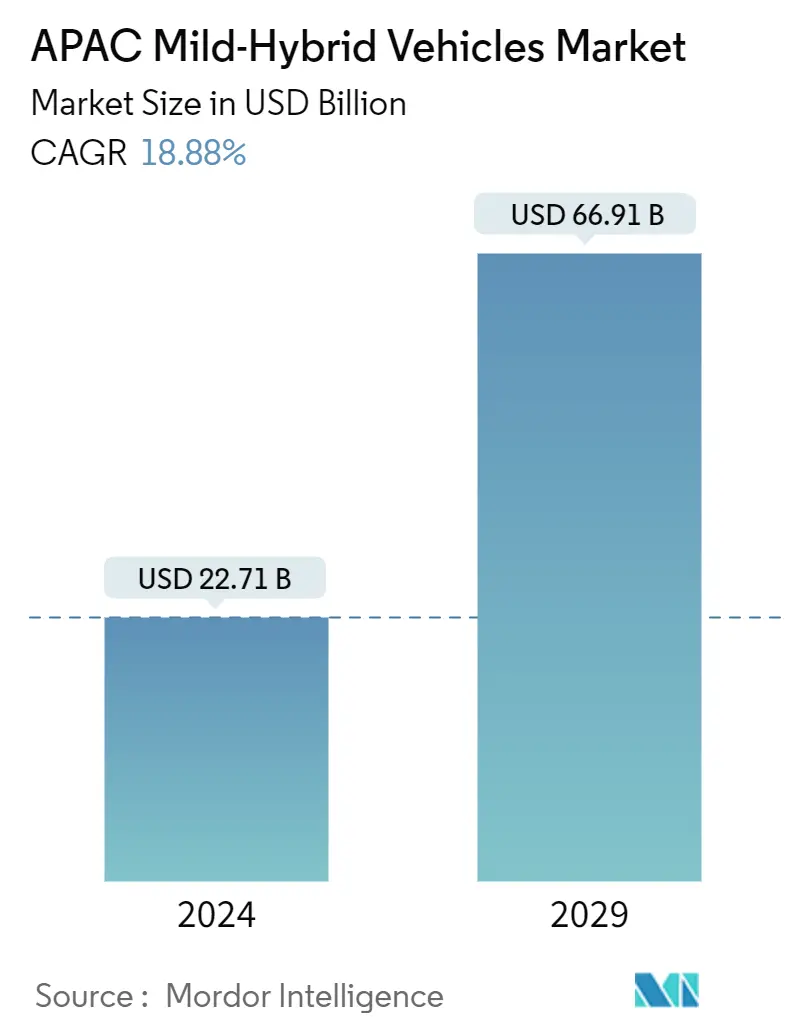
| Study Period | 2019 - 2029 |
| Base Year For Estimation | 2023 |
| Market Size (2024) | USD 22.71 Billion |
| Market Size (2029) | USD 66.91 Billion |
| CAGR (2024 - 2029) | 18.88 % |
| Market Concentration | Medium |
Major Players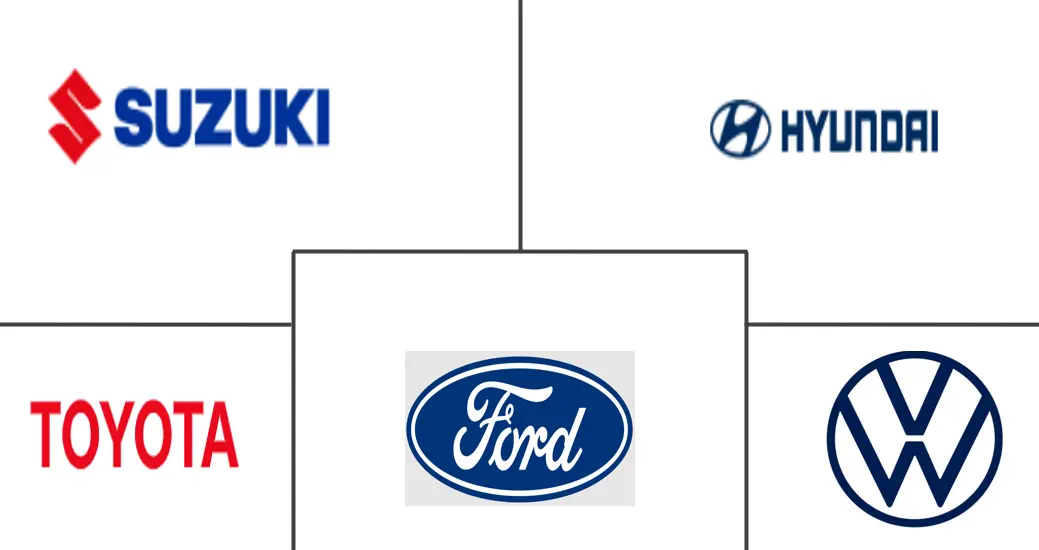
*Disclaimer: Major Players sorted in no particular order |
Asia Pacific Mild Hybrid Vehicles Market Analysis
The APAC Mild-Hybrid Vehicles Market size is estimated at USD 22.71 billion in 2024, and is expected to reach USD 66.91 billion by 2029, growing at a CAGR of 18.88% during the forecast period (2024-2029).
- The COVID-19 pandemic compelled about 95% of all automotive-related companies to put their workforces on hold during the lockdowns. The repercussions of the lockdown were immense and unprecedented due to the halt of manufacturing activities across the region. However, the market was expected to regain its momentum as economic activities resumed and vehicle production rose in 2022 across the region and was likely to witness major growth for the market during the forecast period.
- Over the medium term, growing environmental concerns (owing to rising exhaust emissions), enactment of stringent emissions and fuel economy norms, and increasing government initiatives in terms of subsidies and benefits for increasing the adoption of mild hybrid vehicles across the region.
- Mild hybrid is considered a transitional technology and not a solution to stop carbon emissions. The 48V system can meet the average fuel consumption limit of passenger cars in the fourth and fifth stages (the fourth stage: 5.0L/100km (2020); the fifth stage: 4.0L/100km (2025) with a reduction of 42%), but it is difficult to realize the goal in the sixth stage (3.2L/100km (2030)).
- Incidents of lifting and reduced subsidies for the purchase of electric vehicles may hinder the growth of the market in the region. In India, for instance, the government, in 2017, lifted subsidies on mild-hybrid vehicles under the Faster Adoption and Manufacturing of Hybrid & Electric Vehicles (FAME) scheme (the State of Karnataka lost a subsidy of INR 75 crores from the central government).
Asia Pacific Mild Hybrid Vehicles Market Trends
48V and Above Witnessing Major Growth during the forecast period
- 48V battery was introduced because of the increased need for power to supply electronic elements, like compressors, heaters, power steering, and electric pumps. Many automakers started launching 48V mild-hybrid as standard features in their new vehicle models over the past three years. For instance, in December 2021, the Cadillac division of General Motors Corporation Limited (SAIC-GM) launched the new XT4 compact crossover SUV. The new XT4 boasts better power and configuration. It is equipped with a 2.0L variable-cylinder turbocharged engine with a maximum power output of 174kW, peak torque of 350Nm, and a 48V mild-hybrid powertrain incorporating a 48V motor, 48V power battery, power management module, and hybrid control unit.
- Additionally, Volvo Cars offers the S60 mid-sized sedan in China. The vehicle is available in five mild-hybrid (MHEV) versions and two plug-in hybrid (PHEV) versions. About the powertrain, the MHEV versions are equipped with a B3/B4/B5 turbocharged gasoline engine maximum power output of 120 kW/145 kW/184 kW, peak torque of 265 Nm/300 Nm/350 Nm mated to a 48 V mild-hybrid system.
- Also, several carmakers are working on improving their current existing 48V mild-hybrid systems. For instance, Suzuki few year back unveiled a new hybrid powertrain that will offer up to 20% lower CO2 emissions and higher torque. The mild-hybrid system will also drive-up fuel efficiency by up to 15%. The new system comprises a 48 V lithium-ion battery, Integrated Starter Generator (ISG), and a 48 V-12 V converter (for components that run on 12V systems like air conditioning). The newer powertrain is relatively lighter in weight, and all the components add up to less than 15 kg.
- With the increasing production of 48 V and above voltage mild-hybrid models from automakers, the growth rate of mild-hybrid vehicles in the market is likely to continue to rise positively during the forecast period.
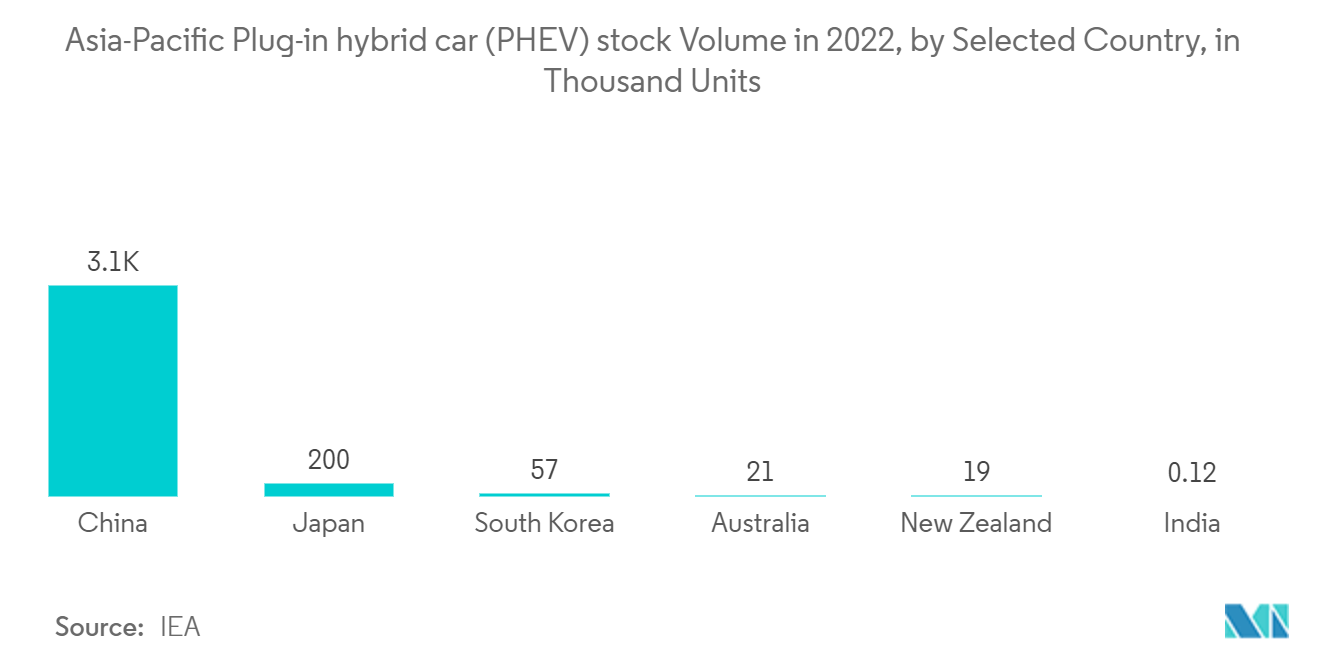
China and India will be the Market Leader
- Electric vehicles (EVs) currently account for less than 1% of the total vehicle sales in India. The market is growing rapidly. The electric four-wheeler registered sales of around 10,54,938 units in 2022. The Government of India has undertaken multiple initiatives to promote the manufacturing and adoption of electric vehicles in India to reduce emissions at international conventions and develop e-mobility in the wake of rapid urbanization.
- The National Electric Mobility Mission Plan (NEMMP) and Faster Adoption and Manufacturing of Hybrid & Electric Vehicles in India (FAME I and II) helped create the initial interest and exposure to electric mobility. The Faster Adoption and Manufacturing of Hybrid & Electric Vehicles in India (FAME) program, which was first implemented in 2015 and updated in 2019, provides consumers and domestic companies with various incentives.
- For instance, in phase two of FAME, the government announced an outlay of USD 1.4 billion through 2022. This phase focuses on the electrification of public and shared transportation by subsidizing 7,090 e-buses, 500,000 electric three-wheelers, 550,000 electric passenger vehicles, and 1,000,000 electric two-wheelers.
- Several major OEM players are launching the latest electric passenger cars in the country to mark their presence in the market.
- For instance, in December 2021, Audi started the local production of the new Q7 SUV at its Aurangabad facility ahead of its expected launch in January 2022. Audi has fitted the Q7 with a 48V mild-hybrid system, owing to India's new BS-VI norms.
- In November 2021, Volvo Cars India updated its flagship SUV, the XC90, with a new mild-hybrid powertrain replacing the diesel variants, which comes with a 300PS 2-liter turbo-petrol teamed with a 48v mild-hybrid system. In October 2021, General Motors launched its Buick GL8 Classic with a 48V mild-hybrid powertrain in China.
- In March 2021, South Korean automobile producer Hyundai launched its new mild hybrid cars. The name of the car, Bayon, is also inspired by a vacation hotspot in the southwest of France. The car is equipped with a 1-liter turbocharged petrol engine and is integrated with 48V mild hybrid technology. Such developments are expected to have a positive impact on the market in focus during the forecast period.
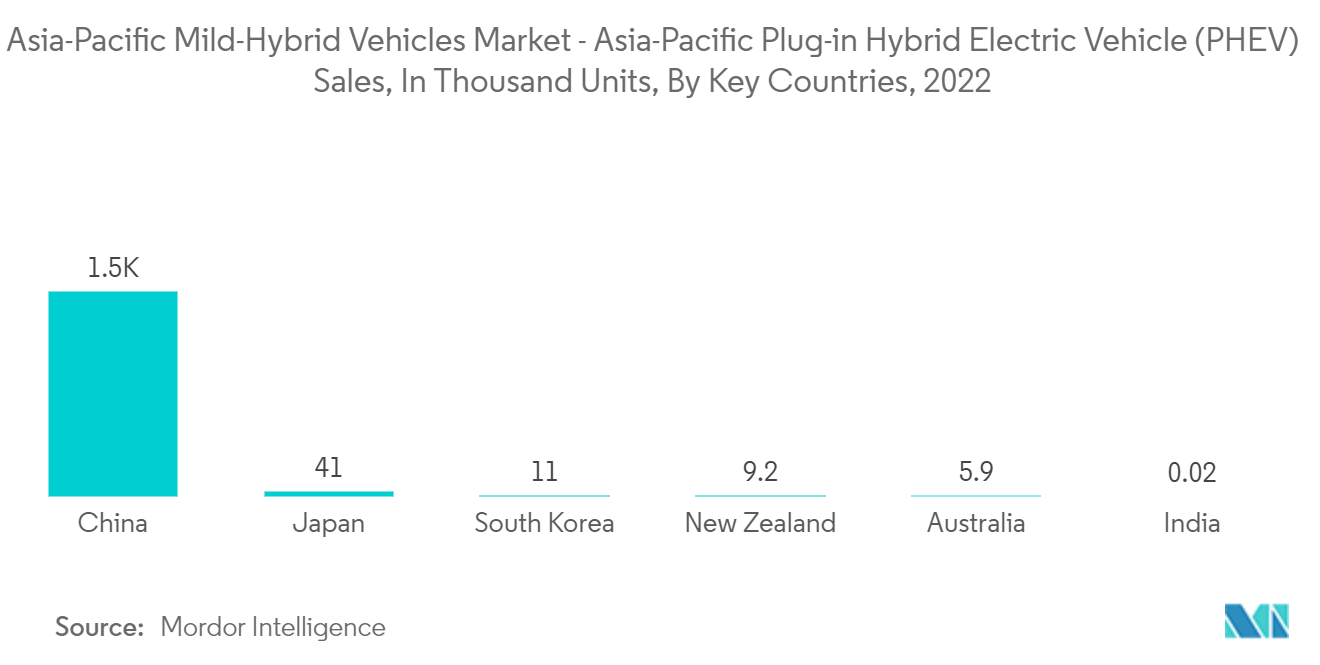
Asia Pacific Mild Hybrid Vehicles Industry Overview
The Asia-Pacific mild hybrid vehicles market is dominated by several key players such as Toyota Motor Corporation, Nissan Motor Company, Honda Motor Company, Hyundai Motor, and others. Companies are investing heavily in research and development for the innovation of new and advanced products and technologies that may help with new technology. For instance, in September 2022, Volvo updated the SUVs and sedans model lineup for 2023, with each of the models now getting a petrol mild-hybrid drivetrain.
In June 2022, Maruti Suzuki India Limited announced that Toyota Motor Corporation and Suzuki Motor Corporation started production of a new SUV model developed by Suzuki at the Toyota Kirloskar Motor Pvt. Ltd. Bidadi plant. The powertrains of the new model to be on sale in India will be equipped with a mild hybrid developed by Suzuki and a strong hybrid developed by Toyota.
In November 2021, Vitesco Technologies opened its new research and development center in Tianjin, China. In Tianjin, Vitesco Technologies develops battery, motor, and electronic control systems for battery electric, full hybrid, and 48 V mild hybrid vehicles.
Asia Pacific Mild Hybrid Vehicles Market Leaders
-
Toyota Motor Corporation
-
Nissan Motor Co. Ltd
-
The Hyundai Motor Company
-
Volkswagen AG
-
Suzuki Motor Corporation
*Disclaimer: Major Players sorted in no particular order
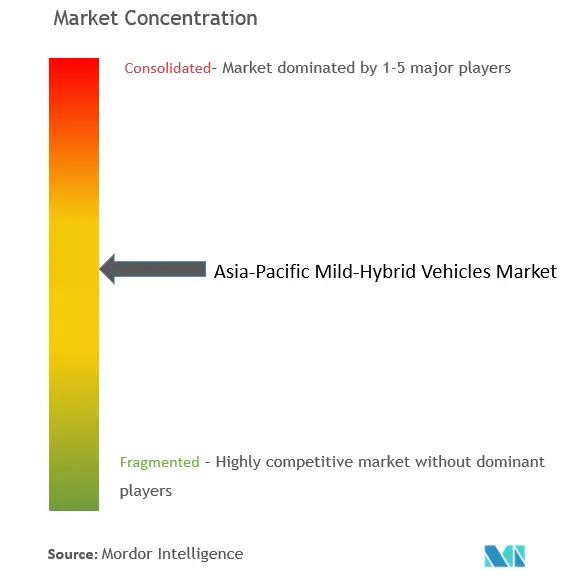
Asia Pacific Mild Hybrid Vehicles Market News
- April 2023: Proton Holding launched the Proton X90, a mild-hybrid car, in the Malaysian market.
- December 2022: Mazda Motor Corporation introduced a new hybrid vehicle model equipped with a strong hybrid mechanism that will allow it to be driven solely by a motor around 2025. The company plans to develop the HV in-house, adopting a "mild hybrid" mechanism to support the engine with a motor.
- November 2022: SAIC Maxus officially launched its new Lingdi mid-to-large-sized SUV in China. The vehicle features SAIC Maxus' mild hybrid diesel-powered Xuanyuan Power Technology and a 48V hybrid architecture.
Asia Pacific Mild Hybrid Vehicles Market Report - Table of Contents
1. INTRODUCTION
1.1 Study Assumptions
1.2 Scope of the Study
2. RESEARCH METHODOLOGY
3. EXECUTIVE SUMMARY
4. MARKET DYNAMICS
4.1 Market Drivers
4.1.1 Fuel Efficiency and Lower Carbon Emission are Likely to Catalyze the Growth Run
4.2 Market Restraints
4.2.1 High Initial Cost
4.3 Porters Five Forces Analysis
4.3.1 Threat of New Entrants
4.3.2 Bargaining Power of Buyers/Consumers
4.3.3 Bargaining Power of Suppliers
4.3.4 Threat of Substitute Products
4.3.5 Intensity of Competitive Rivalry
5. MARKET SEGMENTATION (Market Size in Value - USD Billion)
5.1 By Capacity Type
5.1.1 Less than 48V
5.1.2 48V and Above
5.2 By Vehicle Type
5.2.1 Passenger Car
5.2.2 Commercial Vehicles
5.3 By Geography
5.3.1 China
5.3.2 India
5.3.3 Japan
5.3.4 South Korea
5.3.5 Rest of Asia-Pacific
6. COMPETITIVE LANDSCAPE
6.1 Vendor Market Share
6.2 Company Profiles*
6.2.1 Toyota Motor Corporation
6.2.2 Nissan Motor Co. Ltd
6.2.3 Honda Motor Company Ltd
6.2.4 The Hyundai Motor Company
6.2.5 Kia Motors Corporation
6.2.6 AB Volvo
6.2.7 General Motors
6.2.8 Suzuki Motor Corporation
6.2.9 Volkswagen AG
6.2.10 Mazda Motor Corporation
6.2.11 BYD Motor Co.Ltd
6.2.12 MG Motor India Pvt. Ltd
6.2.13 Mercedes-Benz Group AG
7. MARKET OPPORTUNITIES AND FUTURE TRENDS
7.1 Development of Mild-Hybrid System
Asia Pacific Mild Hybrid Vehicles Industry Segmentation
Mild hybrid vehicles have an internal combustion engine (ICE) equipped with an electric motor, which allows the engine to be turned off whenever the vehicle is coasting, braking, or stopped and restart quickly. Mild hybrid vehicles do not have an exclusive electric-only mode of propulsion. These vehicles employ regenerative braking and some level of power assist to the internal combustion engine (ICE).
The Asia-Pacific mild-hybrid vehicles market is segmented into capacity type, vehicle type, and country. Based on the capacity type, the market is segmented into less than 48 V, 48 V, and above. Based on the vehicle type, the market is segmented into passenger cars and commercial vehicles. Based on the country, the market is segmented into China, India, Japan, South Korea, and the rest of Asia-Pacific.
For each segment, the market sizing and forecast have been done based on the value (USD).
| By Capacity Type | |
| Less than 48V | |
| 48V and Above |
| By Vehicle Type | |
| Passenger Car | |
| Commercial Vehicles |
| By Geography | |
| China | |
| India | |
| Japan | |
| South Korea | |
| Rest of Asia-Pacific |
Asia Pacific Mild Hybrid Vehicles Market Research FAQs
How big is the APAC Mild-Hybrid Vehicles Market?
The APAC Mild-Hybrid Vehicles Market size is expected to reach USD 22.71 billion in 2024 and grow at a CAGR of 18.88% to reach USD 66.91 billion by 2029.
What is the current APAC Mild-Hybrid Vehicles Market size?
In 2024, the APAC Mild-Hybrid Vehicles Market size is expected to reach USD 22.71 billion.
Who are the key players in APAC Mild-Hybrid Vehicles Market?
Toyota Motor Corporation, Nissan Motor Co. Ltd, The Hyundai Motor Company, Volkswagen AG and Suzuki Motor Corporation are the major companies operating in the APAC Mild-Hybrid Vehicles Market.
What years does this APAC Mild-Hybrid Vehicles Market cover, and what was the market size in 2023?
In 2023, the APAC Mild-Hybrid Vehicles Market size was estimated at USD 18.42 billion. The report covers the APAC Mild-Hybrid Vehicles Market historical market size for years: 2019, 2020, 2021, 2022 and 2023. The report also forecasts the APAC Mild-Hybrid Vehicles Market size for years: 2024, 2025, 2026, 2027, 2028 and 2029.
Fluorescent in-Situ Hybridization Industry Report
Statistics for the 2024 Fluorescent in-Situ Hybridization market share, size and revenue growth rate, created by Mordor Intelligence™ Industry Reports. Fluorescent in-Situ Hybridization analysis includes a market forecast outlook 2029 and historical overview. Get a sample of this industry analysis as a free report PDF download.



